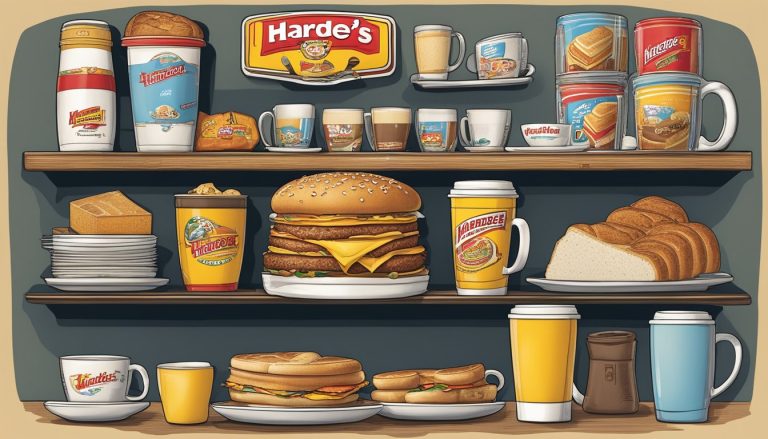Hardee’s breakfast menu offers a variety of hearty options for those seeking a filling start to their day. From biscuits to platters, the chain provides classic American breakfast fare with generous portions. The Hardee Breakfast Platter stands out as a substantial meal, containing between 970-1170 calories depending on the chosen protein.
While Hardee’s breakfast items are known for their satisfying taste, many are high in calories, fat, and sodium. The made from scratch biscuits, a staple of the menu, pack 440 calories and 28 grams of fat each. For those watching their intake, selecting lighter options or sharing meals may be advisable.
Nutritionists often recommend balancing indulgent breakfast choices with healthier options throughout the day. When dining at Hardee’s, considering portion sizes and nutritional information can help make informed decisions. The chain provides this data for consumers interested in managing their dietary intake while still enjoying their favorite breakfast items.
Overview of Hardee’s Breakfast Menu
Hardee’s offers a diverse breakfast menu featuring classic American favorites. The menu includes a range of options to suit different appetites and preferences.
One of the most popular items is the Made from Scratch Biscuits. These come in various combinations, such as with egg, cheese, bacon, or sausage.
For those seeking a heartier meal, the Breakfast Platter is a substantial choice. It typically includes a biscuit, gravy, eggs, hash rounds, and a choice of meat.
Hardee’s also caters to those looking for lighter options. The menu includes items like fruit cups and yogurt parfaits.
Here’s a quick look at some key menu items and their approximate calorie content:
| Item | Calories |
|---|---|
| Biscuit ‘N’ Gravy | 440 |
| Breakfast Platter | 860-1050 |
| Apple Turnover | 280 |
Breakfast combos are available for those who prefer a complete meal. These often include a main item, hash rounds, and a beverage.
Hardee’s breakfast menu aims to provide options for various dietary needs and preferences. The chain offers customization for many of its breakfast items, allowing customers to tailor their meals.
Nutritional Analysis of Popular Items

Hardee’s breakfast menu offers a variety of options, each with distinct nutritional profiles. An examination of the caloric content, macronutrient composition, and micronutrient levels reveals important insights for health-conscious consumers.
Caloric Content and Quality
The calorie counts of Hardee’s breakfast items vary widely. The Sausage Breakfast Platter contains 1150 calories, making it one of the most energy-dense options. In contrast, smaller sides like Hash Rounds provide 260 calories in a small serving.
Bacon and ham versions of the Breakfast Platter offer slightly lower calorie alternatives at 950 and 860 calories respectively. These high-calorie meals may exceed 50% of the recommended daily intake for many adults.
The quality of calories stems primarily from protein-rich eggs and meats. However, refined carbohydrates and saturated fats contribute significantly to the overall calorie count.
Macronutrient Breakdown
Hardee’s breakfast items typically contain a mix of proteins, fats, and carbohydrates. The Loaded Breakfast Burrito exemplifies this with 30g of fat, indicating a substantial portion of its calories come from fat sources.
Protein content varies, with meat-based options providing higher amounts. The Sausage Breakfast Platter offers 30g of protein, supporting muscle maintenance and satiety.
Carbohydrate levels differ across menu items. Hash Rounds, being a potato-based side, are higher in carbs. The Breakfast Platters contain around 75-76g of carbohydrates each, likely from accompanying biscuits or toast.
Fat content is generally high. The Sausage Breakfast Platter contains 68g of total fat, with 24g being saturated fat. This exceeds the recommended daily limit for saturated fat intake for most individuals.
Vitamins and Minerals Profile
Hardee’s breakfast items provide various essential nutrients, though in varying amounts. Eggs in many dishes contribute vitamins A, D, E, and B-complex, as well as minerals like selenium and zinc.
Sodium levels are notably high across the menu. The Sausage Breakfast Platter contains 2310mg of sodium, surpassing the recommended daily limit in a single meal.
Iron content is likely significant in meat-based options, benefiting those at risk of iron deficiency. However, the menu appears limited in fruits and vegetables, potentially lacking in certain vitamins and antioxidants.
Calcium levels may be moderate in items containing cheese or milk-based ingredients. Phosphorus from meat and egg sources is also present.
Health Considerations

Hardee’s breakfast menu presents several nutritional factors that warrant careful consideration. These include the levels of saturated fats and sodium, presence of sugar and artificial additives, and the caloric density of portion sizes.
Saturated Fats and Sodium
Hardee’s breakfast items often contain high levels of saturated fats and sodium. The Hardee Breakfast Platter with bacon provides 56 grams of fat, including 20 grams of saturated fat. This represents a significant portion of the recommended daily intake for saturated fat.
Sodium content is also a concern. The same breakfast platter contains 2300 mg of sodium, which exceeds the daily recommended limit for many adults.
These high levels of saturated fat and sodium can contribute to cardiovascular health issues if consumed regularly.
Sugar and Artificial Additives
Many breakfast items at Hardee’s contain added sugars and artificial additives. While specific sugar content is not provided in the search results, it’s common for fast food breakfast items to include sweetened sauces, syrups, or baked goods.
Artificial additives may be present in various menu items to enhance flavor, texture, or shelf life. These additives can include preservatives, colorants, and flavor enhancers.
Consumers with sensitivities or those seeking to minimize artificial ingredients should be cautious when selecting menu items.
Portion Sizes and Caloric Density
Hardee’s breakfast offerings often come in large portion sizes with high caloric density. The Hardee Breakfast Platter with bacon contains 950 calories, which is a substantial amount for a single meal.
The Hash Rounds side dish ranges from 260 to 490 calories depending on size, adding significant calories to an already energy-dense meal.
Large portion sizes can lead to overconsumption of calories, potentially contributing to weight gain if consumed regularly. Customers should be mindful of portion sizes and consider sharing meals or choosing smaller options to manage calorie intake.
Dietary Accommodations

Hardee’s offers limited options for those with specific dietary needs or preferences. While not extensive, there are some choices available for vegetarians, those avoiding gluten, and individuals following low-carb diets.
Vegetarian Options
Vegetarian selections at Hardee’s breakfast menu are sparse. The Hash Rounds provide a meat-free side option. Some locations may offer a biscuit with egg and cheese, omitting meat components. Grits, when available, offer another vegetarian-friendly choice.
For those who consume dairy and eggs, the Frisco Breakfast Sandwich can be customized without meat. Hardee’s also serves oatmeal at select locations, which can be a nutritious vegetarian breakfast option.
It’s important to note that while these items don’t contain meat, they may be prepared on shared equipment with meat products.
Gluten-Free Choices
Hardee’s does not have a dedicated gluten-free menu. However, some breakfast items can be modified to reduce gluten content. The Low Carb Breakfast Bowl, when ordered without the biscuit, may be suitable for those avoiding gluten.
Standalone eggs and meat items like bacon or sausage patties are typically gluten-free. Hash Rounds are also generally free from gluten ingredients, but cross-contamination is possible during preparation.
Always inform staff about gluten sensitivities to ensure proper handling. Due to shared cooking surfaces, Hardee’s cannot guarantee complete gluten-free status for any menu item.
Low-Carb Alternatives
Hardee’s offers some low-carb options for breakfast. The Low Carb Breakfast Bowl is specifically designed for carb-conscious diners. It includes folded eggs, bacon, and a sausage patty, topped with Swiss cheese.
Customizing orders can create other low-carb meals. Ordering eggs with bacon or sausage without the biscuit reduces carb intake. The Frisco Breakfast Sandwich can be modified by removing the sourdough bread.
Nutritional information for these alternatives varies based on modifications. Hardee’s provides nutrition facts for standard menu items, which can help in estimating carb content for customized orders.
Balancing Convenience with Nutrition

Hardee’s breakfast menu offers quick options for busy mornings. The challenge lies in selecting items that provide both convenience and nutritional value.
Some breakfast choices at Hardee’s can be high in calories, fat, and sodium. For example, the Hardee Breakfast Platter with sausage contains 1050 calories and 2310 mg of sodium.
However, lower-calorie options are available. The Ham, Egg & Cheese Sourdough Breakfast Sandwich has 450 calories and 24 grams of protein, making it a more balanced choice.
To improve nutritional value, consider these strategies:
- Choose smaller portion sizes when available
- Opt for egg-based items for protein
- Select whole grain options if offered
- Add vegetables to sandwiches or platters when possible
- Limit high-fat meats like bacon and sausage
For those watching sodium intake, be aware that many breakfast items exceed 1000 mg of sodium. Requesting less salt or choosing lower-sodium options can help.
Pairing a main item with a side of fruit or oatmeal can add nutrients and fiber to the meal. This approach helps create a more balanced breakfast while still enjoying the convenience of fast food.
Comparative Analysis with Other Fast Food Breakfast

Hardee’s breakfast menu offers a unique mix of hearty options compared to other fast food chains. Their signature biscuits stand out for their flaky texture and generous portions.
McDonald’s provides a wider variety of breakfast items, including healthier choices like oatmeal and fruit parfaits. Their Egg McMuffin remains an iconic breakfast sandwich.
Burger King’s breakfast menu is more limited but includes croissant sandwiches as a point of differentiation. Their hash browns are generally considered crispier than competitors’.
Wendy’s, a relative newcomer to breakfast, emphasizes fresh-cracked eggs and higher quality ingredients. Their Breakfast Baconator has gained popularity among meat lovers.
Nutritionally, Hardee’s breakfast items tend to be higher in calories and fat compared to some competitors. For example:
Calorie Comparison:
- Hardee’s Monster Biscuit: 710 calories
- McDonald’s Big Breakfast: 760 calories
- Burger King’s Double Croissan’wich: 580 calories
Sodium content is a concern across most fast food breakfast menus, with Hardee’s offerings generally on par with competitors.
Hardee’s sets itself apart with its Made From Scratch Biscuits™, which are prepared fresh daily in each restaurant. This commitment to freshness is a key selling point for the brand.
Nutrition Tips for Hardee’s Customers

Hardee’s offers a variety of breakfast options, but some choices are more nutritious than others. Customers looking to make healthier selections can follow these tips:
Choose whole grain options when available. Opt for whole wheat buns or tortillas to increase fiber intake.
Ask for egg whites instead of whole eggs to reduce cholesterol and calories.
Select leaner meats like ham or turkey over high-fat options such as sausage or bacon.
Request vegetables as toppings to add nutrients and fiber with minimal calories.
Consider portion sizes carefully. Smaller portions or sharing larger items can help manage calorie intake.
Be mindful of high-calorie add-ons like cheese, mayo, and special sauces. Ask for these on the side or skip them entirely.
Opt for water, unsweetened tea, or black coffee instead of sugary beverages.
When choosing sides, prioritize fruit cups or plain hash browns over higher-calorie options.
Check nutrition information online or in-store before ordering to make informed decisions.
Balance indulgences with healthier choices throughout the day. Enjoying a treat occasionally can be part of a balanced diet.
Concluding Remarks on Fast Food and Healthy Eating

Fast food restaurants like Hardee’s can be part of a balanced diet when approached mindfully. Occasional indulgence in breakfast items or other menu offerings is unlikely to cause significant health issues.
Regular consumption of fast food meals high in saturated fats, sodium, and calories may contribute to various health problems over time. Moderation is key when incorporating these foods into one’s diet.
Healthier choices are often available at fast food establishments. Opting for items with lean proteins, whole grains, and vegetables can improve the nutritional profile of meals.
Reading nutrition information and ingredient lists helps consumers make informed decisions. Many restaurants now provide this data online or in-store.
Preparing meals at home allows for greater control over ingredients and portion sizes. This approach often leads to more nutritious eating habits overall.
Balancing fast food consumption with home-cooked meals and a variety of nutrient-dense foods is essential for maintaining good health. A well-rounded diet includes fruits, vegetables, whole grains, and lean proteins from diverse sources.




